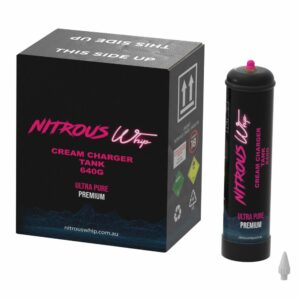Introduction
In the world of cooking arts and contemporary gastronomy, whipped cream chargers-- typically referred to as cream chargers or N2O cream chargers-- have ended up being a necessary tool for attaining that ideal, fluffy topping. However, in the middle of their appeal lies a sixty-four-thousand-dollar question: what is the ecological impact of nitrous oxide cream chargers? This article intends to dig deep into this subject, checking out both the advantages and the repercussions of utilizing these devices in our kitchens, cafes, and restaurants.

What Are Whipped Cream Chargers?
Whipped cream chargers are little steel cylinders filled with nitrous oxide (N2O), a gas that acts as a propellant when creating whipped cream. These chargers are generally utilized in combination with whipped cream dispensers, allowing users to create light and airy whipped garnishes rapidly and effectively.
Understanding Nitrous Oxide (N2O)
What is Nitrous Oxide?
Nitrous oxide is a colorless gas with a somewhat sweet odor, typically understood for its uses in different industries, including medicine (as an anesthetic), automobile (in racing for enhancing engine performance), and culinary applications (as a whipping agent).
How Does It Work?
When laughing gas is launched from the battery charger into a cream chamber, it dissolves in the liquid cream under pressure. Upon release of pressure, N2O forms bubbles within the cream, resulting in that wonderful whipped texture all of us adore.
Culinary Uses of Cream Chargers
Beyond Whipped Cream
While most folks associate N2O cream chargers solely with whipped cream, they can likewise be utilized to instill tastes into liquids or perhaps develop foams for sophisticated cocktails.
Why Are They Popular?
The benefit and speed of using whip cream chargers have actually made them popular among both home cooks and professional chefs. They're effective and need very little clean-up compared to standard whipping methods.
The Environmental Effect of Nitrous Oxide Cream Chargers Explained
As we delight in tasty desserts topped with newly whipped cream from a dispenser utilizing nitrous oxide cream chargers, it's important to examine their ecological implications. On one hand, they use convenience; on the other hand, they contribute substantially to greenhouse gas emissions.
The Greenhouse Gas Effect
Understanding Greenhouse Gases
Greenhouse gases trap heat in Earth's environment. While carbon dioxide typically gets most of the https://writeablog.net/lefwenceub/cream-chargers-101-whatever-you-need-to-understand-about-whipping-magic attention due to its high volume emissions from fossil fuels, nitrous oxide is actually 298 times more potent than CO2 over a 100-year period.
N2O Emissions: A Hidden Threat
Nitrous oxide emissions mostly stem from farming activities but utilizing nitrous oxide cream chargers adds to this issue as well. The production and disposal processes add more pressure on our environment.
Production Process of Nitrous Oxide
How Is N2O Produced?
Nitrous oxide is produced through several techniques:
Chemical Reactions: It's synthesized from ammonia and nitric acid. Biological Processes: Germs transform nitrogen substances into N2O throughout soil cultivation. Combustion: Burning nonrenewable fuel source can likewise generate laughing gas as a byproduct.Environmental Costs
From extraction to making procedures-- the production of laughing gas involves energy-intensive treatments that contribute to pollution and habitat destruction.
Life Cycle Analysis of Cream Chargers
From Production to Disposal
When evaluating the environmental impact of laughing gas cream chargers, think about each phase:
Raw Product Extraction Manufacturing Distribution Usage End-of-life DisposalEach stage has its unique ecological footprint that accumulates over time.
Sustainable Alternatives
Exploring Eco-Friendly Options
With increasing awareness about environment modification and sustainability:
- Biodegradable choices are emerging. Reusable whipped cream dispensers offer an eco-friendlier alternative. Some brands are working on producing non-N2O alternatives.
The Carbon Footprint of Cream Chargers
How Do We Determine It?
Calculating the carbon footprint includes examining emissions through each lifecycle phase mentioned above.
|Phase|Estimated CO2 Equivalent Emissions|| ------------------------|-------------------------------------|| Production|X kg CO2|| Circulation|Y kg CO2|| Use|Z kg CO2|| Disposal|A kg CO2|| Overall|B kg CO2|
This table highlights how apparently little actions can collect substantial emissions over time.
Consumer Awareness and Responsibility
What Can You Do?
Consumers play a pivotal role in lowering the ecological impact:
- Opting for reusable dispensers Limiting waste by acquiring only essential quantities Keeping informed about brands devoted to sustainability
FAQs About Nitrous Oxide Cream Chargers
1. What are whipped cream chargers made from?
Whipped cream chargers are made from stainless-steel or aluminum including compressed nitrous oxide gas.
2. Exist any health threats related to using nitrous oxide?
While typically safe when utilized properly in culinary applications, abuse can result in health risks such as oxygen deprivation or neurological concerns if breathed in directly.
3. What takes place if you dispose of them incorrectly?
Inappropriate disposal can result in contamination; they must be recycled where possible due to the fact that they are made from recyclable materials.
4. Can I reuse whipped cream chargers?
No; once empty or punctured, they can not be reused securely due to prospective threats connected to residual gas pressure.
5. How do I select sustainable alternatives for whip creams?
Search for brand names that focus on environment-friendly materials or those offering multiple-use items instead of single-use items.
6. Exists an alternative to laughing gas for whipping creams?
Yes! Some companies have developed non-N2O based technology that offers similar results without contributing as greatly to greenhouse gases.
Conclusion
As we appreciate our delightful dishes topped with luscious whipped creams made possible by laughing gas cream chargers, it's crucial we stay mindful of their ecological impact. The Ecological Impact of Laughing Gas Cream Chargers Explained has unveiled important insights on these ubiquitous tools we often consider approved in our kitchens.
By understanding both the benefits and effects connected with their use-- and employing more sustainable practices-- we can take pleasure in these cooking delights without compromising our world's health for future generations.